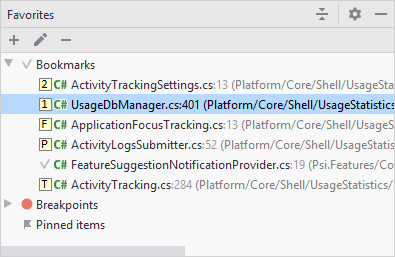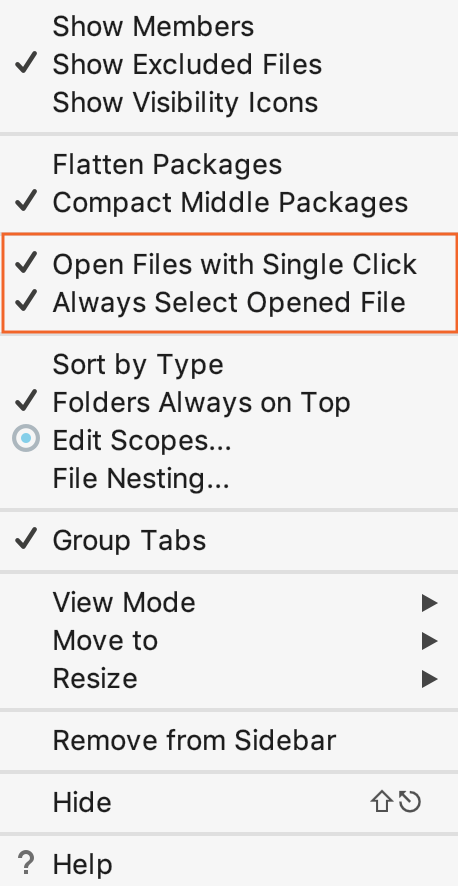Source code navigation
You can quickly navigate through code in the editor using different actions and popups.
You can start with watching a video tutorial to check what navigation options are available in MPS.
Navigate with the caret
-
To navigate backwards, press Ctrl+Alt+Left. To navigate forward, press Ctrl+Alt+Right.
To navigate to the last edited location, press Ctrl+Shift+Backspace.
To find the current caret location in the editor, press Ctrl+M. This action might be helpful if you do not want to scroll through a large file.
However, you can press the Up and Down arrow keys to achieve the same result.
To highlight a word at the caret you are trying to locate, select from the main menu.
To see on what element the caret is currently positioned, press Alt+Q.
To toggle between the starting and ending code block braces, press Ctrl+Shift+M.
To navigate between code blocks, press Ctrl+Shift+[ or Ctrl+Shift+].
Move the caret
You can use different actions to move the caret through code. You can also configure where the caret should stop when moved by words and on line breaks.
- To move the caret to the next word or the previous word, press Ctrl+Right or Ctrl+Left.
By default, MPS moves the caret to the end of the current word.
When you move the caret to the previous word, the caret is placed in the beginning of the current word. You can configure the position of the caret when you use these actions.
In the Settings/Preferences dialog Ctrl+Alt+S, go to . In the Caret Movement section, use the When moving by words and Upon line break options to configure the caret's behavior. -
To move the caret forward to the next paragraph or backward to the previous one, press Ctrl+Shift+A and search for the Move Caret Forward a Paragraph or Move Caret Backward a Paragraph action.
You can also select a text and then move the caret forward or backward to a paragraph. Press Ctrl+Shift+A and search for the Move Caret Forward a Paragraph with Selection or Move Caret Backward a Paragraph with Selection action.
If you need, you can assign shortcuts to these actions. Refer to Configuring keyboard shortcuts for details.
Find recent locations
You can also check your recently viewed or changed code using the Recent Locations popup.
-
To open the Recent Locations popup, press Ctrl+Shift+E. The list starts with the latest visited location at the top and contains code snippets.
-
While in the popup, use the same shortcut or select the Show changed only checkbox to see only the locations with changed code.
-
To search for a code snippet, in the Recent Locations popup, start typing your search query. You can search by the code text, filename, or breadcrumbs.
-
To delete a location entry from the search results, press either Delete or Backspace.
Keep in mind that the deleted location is also removed from the list of entries that you access with the Ctrl+Alt+Left shortcut.
Use bookmarks for navigation
To create an anonymous bookmark, place the caret at the needed code line and press F11.
To create a bookmark with mnemonics, place the caret at the needed code line, press Ctrl+F11 and select a number or a letter for the mnemonics.
To show the next or the previous bookmark, in the main menu select or .
To open the Bookmarks dialog, press Shift+F11. You can use this dialog to manage bookmarks, for example, delete, sort bookmarks, or supply them with a brief description.

To navigate to an existing bookmark with letter mnemonics, press Shift+F11 and then press a letter you need. MPS returns you to the editor and to the corresponding bookmark.
To navigate to an existing bookmark with number mnemonics, press Ctrl and the bookmark's number.
Every created bookmark is reflected in the Favorites Alt+2 tool window which you can also use for navigation to your bookmarks.

Go to declaration and its type
You can navigate to the initial declaration of a symbol and symbol's type from its usage.
-
Place the caret at the desired symbol and press Ctrl+B.
-
For a type declaration, press Ctrl+Shift+B.
Go to implementation
You can keep track of class implementations and overriding methods either using the gutter icons in the editor or pressing the appropriate shortcuts.
Click one of the
 /
/  ,
,  /
/ gutter icons located in the editor and select the desired ascendant or descendant class from the list.
gutter icons located in the editor and select the desired ascendant or descendant class from the list. To navigate to the super method, press Ctrl+U.
To navigate to the implementation, press Ctrl+Alt+B.
Navigate with the Select In popup
You can automatically locate a class in the Project tool window.
If the class is opened in the editor, press Alt+F1 to open the Select In popup.

In the popup, select Project View and press Enter. MPS locates your target in the Project tool window.
Locate a file in the Project tool window
You can use the Open Files with Single Click and Always Select Opened Files actions to locate your file in the Project tool window.
In the Project tool window, right-click the Project toolbar and from the context menu select Always Select Opened File. After that MPS will track the file that is currently opened in the active editor tab and locate it in the Project tool window automatically.

You can also select the Open Files with Single Click option. In this case, when you click a file in the Project view, MPS will automatically open it in the editor.
Locate a code element with the Structure view popup
You can use the structure view popup to locate a code element in the file you are working on.
To open the structure view popup, press Ctrl+F12.
- In the popup, locate an item you need. You can start typing a name of the element for MPS to narrow down the search. Press Enter to return to the editor and the corresponding element.
While in the popup, you can sort file members, see anonymous classes and inherited members.
Browse through methods
Use the Lens mode
The lens mode lets you preview your code without actually scrolling to it. The mode is available in the editor by default when you hover your mouse over the scrollbar. It is especially useful when you hover over a warning or an error message.
To disable the lens mode, right-click the code analysis marker located on the right side of the editor and in the context menu clear the Show code lens on the scrollbar hover checkbox.
-
As an alternative, in the Settings/Preferences dialog Ctrl+Alt+S, go to and clear the Show code lens on the scrollbar hover checkbox.
Use breadcrumbs for navigation
You can navigate through the source code with breadcrumbs that show names of classes, variables, functions, methods, and tags in the currently opened file. By default, breadcrumbs are enabled and displayed at the bottom of the editor.
Find a line or a column
Find a file path
In the editor, press Ctrl+Alt+F12 or in the context menu, select Reveal in Finder.
In the Reveal in Finder popup, select a file or a directory to open in a path finder and press Enter.
Find recent files
You can search for the recent and recently edited files with the Recent Files popup.
To open the Recent Files popup with the list of recent files, press Ctrl+E.
To see only the recently edited files, press Ctrl+E again or select the Show changed only checkbox.
To search for items in the popup, start typing the search query. MPS displays the results based on your search.
